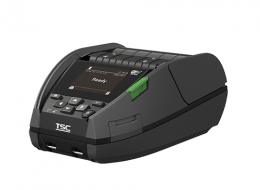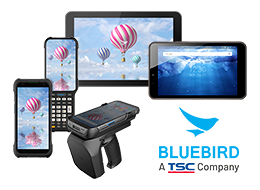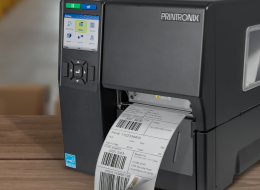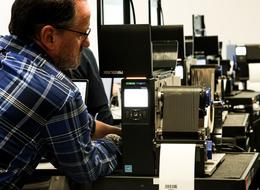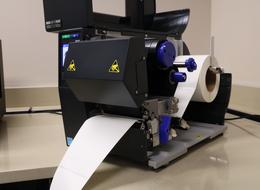Regulatory Labeling Compliance
Trade is accelerated by consistency in information exchange. If both parties know when, how, and where money and information will be exchanged, the transaction happens more rapidly.
Product labeling is the universal methodology for information exchange on shipped goods. Consistency in labeling can be achieved by regulatory agencies creating policies, global organizations developing worldwide standards, or even a dominant player taking a lead dictating standards others adopt as well.
Non-compliance to these standards can result in fines, returned shipments, audits, and additional time spent in transporting, receiving, and processing goods. Delays of this sort are not readily accepted in a world already struggling with logistics constraints. Described below are a sampling of the various compliance requirements, and benefits of TSC Printronix Auto ID printers in generating compliant labels.
Labeling mandates and compliance tend to fall into the following categories:

Serialization
Ensuring each device has a unique serial number for tracking and, if needed, recall. The objective is to ensure no missing or duplicate serial numbers, and the serial number clearly marked on the item. Please see our solutions in this area in collaboration with software partners for unique serialization. Examples of serialization regulations include:
Unique Device Identification (UDI) Labeling | UID (Unique Identification) and Item Unique Identification (IUID) Labeling Compliance | Drug Supply Chain Security Act (DSCSA) |
The US Food and Drug Administration (FDA) requires that all medical devices distributed in the United States be labeled with a Unique Device Identifier (UDI). | The US DoD and NATO specified unique ID requirements including MIL-STD-129P, and MIL-STD-130. | The US Food and Drug Administration (FDA) specifies label and serialization requirements for drugs. |

Label Content
These compliance requirements include specifying format, content, barcode symbology, and required elements or symbology on the label. Please see our comprehensive range of printer solutions with a wide range of printer-language emulations and advanced print functions to provide support for a wide range of label sizes, substrates, and datastreams. Examples of content regulations include:
Globally Harmonized System (GHS) Labeling | US Healthcare Label Compliance | European Union Medical Device Regulation (EU MDR) Labeling |
The Globally Harmonized System of Classification and Labeling of Chemicals (GHS) was enacted to improve safety and protect the health of workers within the chemical industry. | The US Food and Drug Administration has specified requirements for label format and content, including FDA 21 CFR Part 11, HIBC, HIBCC, ICCBBA, GUDID, blood bag labels, and biologic sample labels. | The EU MDR is designed to ensure public health and safety across Europe and to increase quality and transparency of medical devices through label design, approval, and tracking standardization. |
GS1 Labeling Compliance | Food Labeling Compliance | Automotive Compliant Labeling |
GS1 barcodes are a de facto worldwide standard used for traceability of logistic units including GS1-128, GS1-Datamatrix, GS1-Digital Link, and SSCC. | Requirements for food labeling include the Food Safety Modernization Act (FSMA), EU Regulation 1169/2011 on the Provision of Food Information to Consumers (FIC), Produce Traceability Initiative (PTI), and US Food and Drug Administration requirements for nutrition labels, alcoholic beverage labels, and food allergen labels. | Mandated content and format labels for incoming goods including AIAG, GM, Odette, VDA, and GTL. |
Transportation Industry Compliance | Airline Industry Compliance | Telecommunication Industry Compliance |
Compliant labels within the transport industry include SSCC, UPD, USPS, Walmart, and SSC14. | Airline industry compliant labeling includes mandates from ATA Spec 2000, International Air Travel Association (IATA), Boeing, and Airbus. | Compliant label requirements within the telecommunications industry include the Telecommunications Industry Forum (TCIF) and TLC39. |
Retail Industry Compliance | Environmental Labels |
|
Specifications for label content and format come from large US retailers, including Amazon, Walmart, Target, Hudson Bay, Macy’s and others. | Specifications for label content, symbol inclusion, and format include EU Energy Label and Energy Star. |
|

Media Specifications
In addition to label content, physical attributes such as label size, substrate, color, and material may also be mandated by regulatory agencies, industry groups, or industry leaders. Please read about our large selection of label and ribbon media, providing a wide range of solutions for compliance applications. View label markets we serve >
Do you have questions about media specifications? Contact one of our supplies experts today. Click here for media specification support >

Readability Metrics
A perfectly designed label printed on the compliance material will fail absolutely if the information on the label cannot be read. The American National Standards Institute (ANSI) defined a barcode grading schema adopted by the International Standards Organization (ISO) as ISO-15415 for 2D barcodes and ISO-15416 for 1D barcodes. Regulations or customers not only define label content and material, but also minimum ISO grades for barcode readability.
Please read about our solutions for integrated barcode validation and verification. Providing the easiest solution to implement without external scanners, PCs, templates, or operator intervention, every barcode on every label on every job will be found, read, and graded. The grading report is available for archival to defend against chargebacks or fines.
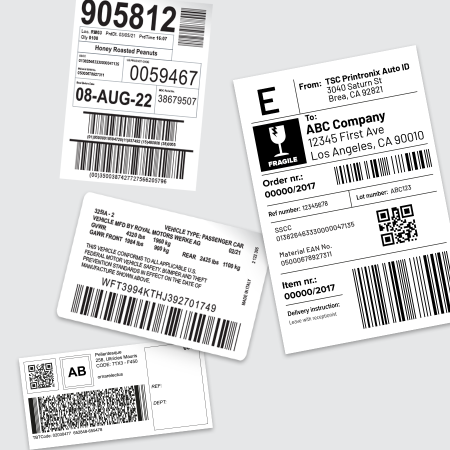
Additional Compliance Resources
How To Perfect Your Barcode Labels with Our ODV-2D Automated Verification Printers and TEKLYNX Software
What Barcode Professionals Need to Know about RAIN RFID Tag Selection and Sourcing
An Introduction to RAIN RFID Numbering Systems for the Pharmaceutical Industry
The Essential Guide to Getting Started with Barcode Verification and Validation
How the Cannabis Industry Uses RFID Technology to Cultivate Business Intelligence from Seed to Sale
Compliance Labeling Support
| Category | Associated Standards/Keywords | RFID |
|---|---|---|
| Amazon Transparency | Data Matrix, QR Code, authenticity, verification | |
| Automotive | AIAG, GM, Odette, VDA, GTL | ⬤ |
| Aviation & Aerospace | ATA Spec 2000, IATA, Boeing, Airbus | ⬤ |
| Cannabis | Canada Cannabis Act, metrc | ⬤ |
| Caterpillar | ||
| Chemical Industry | Globally Harmonized System (GHS), Hazardous chemical | |
| Defense Industry | Unique Identification (UID), Item Unique Identification (IUID), Department of Defense (DoD), NATO, MIL-STD-129P, Military | ⬤ |
| Environmental | EU Energy Label, Energy Star | |
| Food & Beverage | Produce Traceability Initiative (PTI), Food Safety Modernization Act (FSMA), Nutrition Label, Food Allergen Label, EU Food Information to Consumers (FIC), US Food and Drug Administration (FDA) | ⬤ |
| Government | NATO, US Department of Defense (DoD) | ⬤ |
| GS1 | Logistics, Retail, GS1-128, GS1 Digital Link, SSCC, UPC, EAN, EPC | ⬤ |
| Healthcare | HIBC, HIBCC, FDA, 21 CFR Part 11, Blood bag, Biologic samples, ISBT 128, ICCBBA, DoseID | ⬤ |
| Logistics | Shipping, SSCC, Walmart, UPS, USPS, SSC14 | ⬤ |
| Medical Device Identification | FDA, 21 CFR Part 11, HIBC, GS1, HIBCC, ICCBBA, GUDID, EU MDR, Unique Device Identification (UDI) | ⬤ |
| Pharmaceutical | FDA, 21 CFR Part 11, Drug Supply Chain Security Act (DSCSA) | ⬤ |
| Supplier Compliance Labeling | Walmart, Target, Hudson Bay, Macy's, Retail, Mandate | ⬤ |
| Telecommunications | Telecommunications Industry Forum (TCIF), TLC39 |

